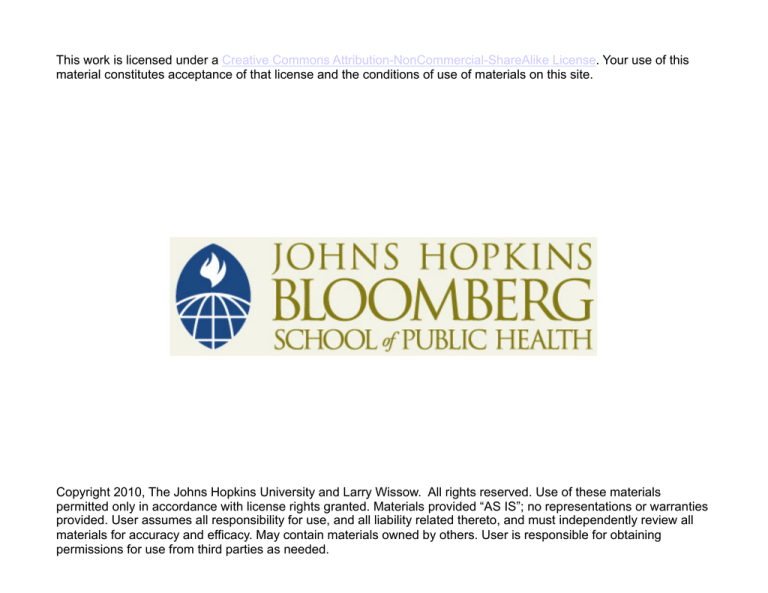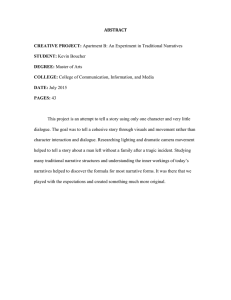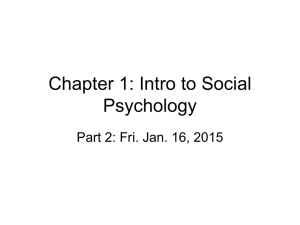
This work is licensed under a Creative Commons Attribution-NonCommercial-ShareAlike License. Your use of this
material constitutes acceptance of that license and the conditions of use of materials on this site.
Copyright 2010, The Johns Hopkins University and Larry Wissow. All rights reserved. Use of these materials
permitted only in accordance with license rights granted. Materials provided “AS IS”; no representations or warranties
provided. User assumes all responsibility for use, and all liability related thereto, and must independently review all
materials for accuracy and efficacy. May contain materials owned by others. User is responsible for obtaining
permissions for use from third parties as needed.
What’s a theory
“A set of interrelated concepts, definitions,
propositions that presents a systematic view of
events or situations by specifying relations
among variables in order to explain and predict
the events or situations.” (Glanz)
An exercise in “worldmaking”
What are the relevant concepts
- How might they be connected
-
Something testable
Why use theories in research?
To try to understand mechanisms
Make complex situations comprehensible – at
some level a simplification
Guide observation
-
To help avoid post-hoc explanations based on
chance results
-
To make sure we include observations felt to be
relevant
-
To generate data that is comparable across settings
Why use theories in practice?
To the extent that a theory is supported by data
(ie, felt to approximate an underlying
mechanism)
-
Provides guidance for points of intervention
-
Suggests appropriate ways to measure process and
outcome
-
Gives a framework for analyzing what went wrong
Problems with theories
Easy to mistake for “truth”
Multiple theories can validly explain the same
thing
Need to be careful that test of theory properly
measures the concept
-
Concepts are not always well defined
-
Concepts are only imperfectly mapped on to
measures
Theories vary in their level of specificity
Development
Individuals, families, and other groups evolve
over time.
Changes in competencies, needs, perceptions,
motivation.
Changes in ability to interact with the
environment, and which levels of the
environment interact with
Transactional
Individuals don’t just respond to their
environment, they interact with it.
-
“reciprocal determinism”
The environment is not a fixed thing – its
“reality” is in part a function of perception and of
behavior.
People can and do alter their reality.
Resilience
Successful growth and adaptation
(sometimes called resilience) is determined
(at least in part) by the ability to “organize”
experience – to make sense of it, and to
achieve an inner state of regulation that
allows optimal interaction with the external
world.
The essence of “transactional?”
Narrative as an organizing
mechanism
Narrative defined:
A story or account that an individual speaks
or writes about an event, a situation, an
illness, or about past or present
relationships.
Narratives put events in temporal or causal
order, and link possibly unrelated events
into a coherent whole.
Contain an implicit or explicit message
Importance of narrative
Thought to be mechanism by which people
create “meaning” and predict the outcome
of behavioral choices
“Meaning” defined as personal implications
of events, relationships, objects.
Pause here to discuss our own sense of
meaning and how it relates to adaptation
and purpose
Meaning and the brain
Brains seem to organize experience in the form of
stories that play out the implications of
experience.
-
The brain devotes much activity to developing and
“satisfying” expectations (Bechara)
-
Ventro-medial pre-frontal cortex (VMPC) links the
stories (memories) to affective states
Area called the ventral striatum involved in anticipation
and to arousal during uncertainty; relieved when the
anticipated happens
Stories that “make sense” trigger relaxation
What makes a good story?
Our own ideas
From the reading?
How are stories different from data?
What are different uses of narrative/
stories?
To convey information
To persuade
-
Tool for “overcoming resistance”
As a repository of information
To “make sense” and thus to heal or
understand
-
Convey ideas/emotions that are too complex for an
essay or even a conversation
Characteristics of healing
narratives (for the author) (DeSalvo)
explicit and rich in detail
link feelings to events
balance use of positive and negative
emotional words
reveal insights from painful or adverse
experiences
tell a complete (enough), coherent story
Observational data
Taylor: Women with breast cancer had
better health status if:
Viewed cancer as reason to re-evaluate life and
values
- Developed sense of those more and less
fortunate
-
Experimental data
Pennebaker: write your “deepest thoughts
and feelings” about a significant stressful or
traumatic life experience for 15 minutes a
day over the course of 3 days.
Decreased anxiety, distress, improved
immunologic functioning, better overall
functioning.
What about reading or hearing
narratives?
Similar to reading “thick description” in
anthropology: humanizes what is different
Active attempt to discern structure and logic
of story rather than force it into one’s own
Active association of the story with one’s
own experiences
Willingness to tolerate emotions
Why read it aloud?
Audio/visual presentations can be powerful policy and
teaching tools
-
-
Reading it aloud really allows the voice to come through
It’s a short trip from here to radio drama and other behavior change
tools
Practice listening is as important as practice writing and
reading
Speaking in front of others is a skill that is worth practicing
Your thoughts and experiences are a gift to the rest of us.








